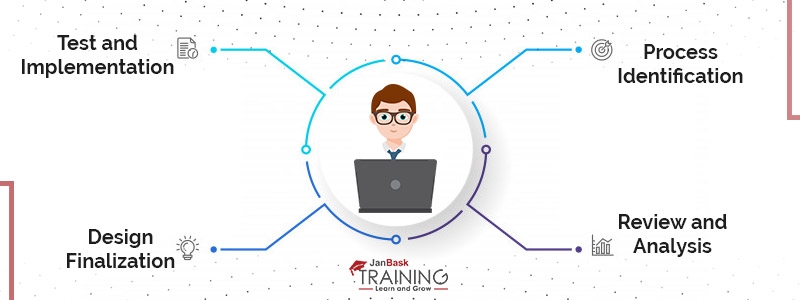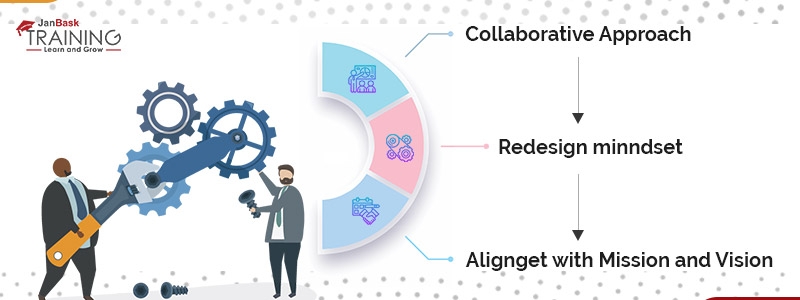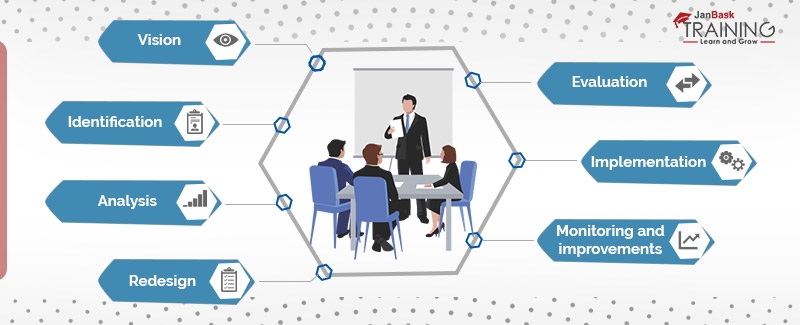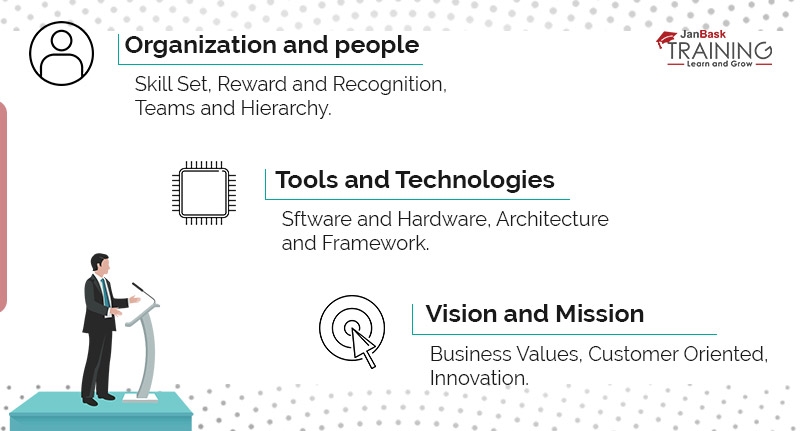09
JanYear End Sale : Get Upto 50% OFF on Live Classes + $999 Worth of Study Material FREE! - SCHEDULE CALL
Business Process Re-engineering is a very important concept when trying to bring in something innovative in the way business is implemented. The details cited below will give you clarity on the fundamentals behind the business process re-engineering.
The knowledge shared in this blog has a practical angle to the topic. It will help you in understanding the basics very clearly. So, let’s see the highlights as what all we are covering in this blog -
Business Process re-engineering is an art of redesigning the core business process and implementing radical thinking for better growth, performance, efficiency, and revenue. It can also be said as an analysis principle which is implemented to redesign business processes across organization. The goal is focused to improve overall product quality with higher revenue for the company. Business Process re-engineering is sometimes also said as a business management strategy that focuses on redesign workflows and business processes.
It has helped organizations to restructure their business functions and their business processes to deliver flawless products. The steps for business process re-engineering are aligned logically and implemented to have maximum efficiency. The focus is on business goals.
You might be Intrested in - Business Analyst Tutorial Guide for Beginner
To understand it better, we can also call it a makeover, which formulates organizations’ inputs to business outputs.
Check out the diagrammatic representation of Business Process Re-engineering -

Business Process re-engineering was first used in the 1990s. It sees with a very holistic approach as it focuses on business goals. It would not wrong if this re-engineering method is named “Business Transformation”.
Obviously, BPR is a heavy analytical task. The employees of the organization have to go under various brainstorming sessions to come with the redesign process. In a way, a lot of rethinking process and creativity needs to be applied. This helps to come up with out of the box ideas. The focus of so much rethinking is to have better support for the organization’s mission and vision.
Business Processing Re-engineering has to be a collaborative approach. It takes a closer look at all the business units. No one is single-handedly responsible for the success of this redesign. That’s the reason these are divided into multiple sub-processes.
Read: Must-Have Professional Business Analyst Skills To Kickstart Your Career!
Initially, it came up to improve customer service, reduce overall costs and to beat the competitors. With that fundamental, it explains it much better how accurate this redesign process needs to be.
We need to be very clear that this re-engineering changes processes and not business units. The reason business process re-engineering has become so important is to deal with our competitors.

Business Process Re-engineering revolves around four main pillars -
By taking a closer look at the definition, don't we get a fair idea as to how business process re-engineering is revolving around these four pillars? These are the basic concept behind BPR in any organization.
So if we combine all four, we can conceptualize BPR as a fundamental rethinking and radical redesign of business processes to see dramatic improvements in growth, efficiency, and revenue. Let’s understand each one of them -
The first step in business re-engineering should be analyzing the fundamental operations of our businesses. A couple of questions must be asked and analyzed -
Radical re-engineering is always associated with a re-design mechanism. It is always seen as coming up with new ideas and innovation so as to discard the existing one. Radical re-engineering can be visualized as a reinvention with a strong knowledge of fundamental operations of the business.
The process can be defined as basic steps followed in a specific manner to produce some valuable output. They usually have a sequential flow, but sometimes it also follows a parallel flow.
From any clothing app, a customer orders a piece of shirt. The organization follows a defined process to deliver the product. The order gets received followed by its confirmation. Then the order gets packed at the warehouse, followed by it being shipped. Next, the order passes through various delivery hubs and finally getting delivered to the customer. Yes, these processes are also looked upon to be changes based on various experiences and feedbacks.
So now you would be getting an idea of what exactly the concept of the dramatic means. It focuses on overall performance improvements, unlike marginal improvements and modifications.
All these four pillars if applied effectively helps companies to stand out from competitors.
Read: Why Finance Domains For Business Analysts Had Been So Popular Till Now?
Details on Business Process Re-engineering Lifecycle
Business Process Re-engineering lifecycle is the recent methodologies that have been added for Business Process Re-engineering. As process re-engineering requires immense effort, it is important that it follows a sequential step to achieve the end result.
That’s why BPR Lifecycle has six steps which are being followed in the sequential pattern –
Let’s see each one of them –
Envision – This step helps to visualize re-engineering opportunities and identify emerging technologies. This, in turn, helps to align the organization’s strategies so as to achieve a common goal.
Initiate – Initiation of business process re-engineering means starting the work and setting up the right expectations. This calls for kick-off meeting and an organized team is being formed for BPR. The formation of a structured team helps people to realize the ultimate goal and work towards it.
Process Diagnosis – This step helps to track the process being followed by reviewing the current process on a timely basis. The aligned team checks for any bottlenecks and issues throughout the journey of business process re-engineering.
Process Redesign – These steps are implemented immediately after diagnosis. All the alternative flows are being identified and new architecture is being designed. Make sure when process redesign is being implemented it follows a set of agreed protocols.
Reconstruction – Reconstruction step helps to finalize the implementation plan after the diagnosis has been done and redesign methodology has been decided.
Process Monitoring – The end step of this lifecycle calls for monitoring the new changes. The redesigned methodology should be aligned with quality output and so it needs constant monitoring
Below diagram would help you to have a simplified look on business process re-engineering -

Read: How Writing Good User Story For A Business Analyst Can Increase Your Profit!
Let’s see some of the examples which would constantly need redesign -
Suppose the launch of any new item takes two months, but the market and competition say that every week a new product is launched. So this would call for re-engineering, where thought could having variations of each product type and bringing to the website every week.
So by replacing so much manual effort, it increases the efficiency and performance of this particular business unit. The resultant is that employees have their entire data - profile, insurance, paycheques details, retirement details, employee benefits, and policies integrated into one system.
You might be intrested in - How to Be the Best Business Analyst?
There are some core principles behind business process re-engineering. Let’s see each one of them -
Now having known the principles of BPR, it is important for us to understand the framework behind it. Business process re-engineering follows the approach of reinventing the wheel which means revisiting each and every process from scratch and working towards the reinvention. The final goal of setting up this framework is for the prompt end product in order to increase performance, growth, and revenue.
BPR Framework revolves under three components -

By now you would have definitely understood that business process re-engineering has multiple benefits for the organizations. Let’s see some of its advantages -
Thus, we now have an understanding that business process re-engineering is a strategic approach that helps organizations to always be ready for the change. It is managed in a way of project and always owned by the organization. BPR is not a miracle but it's also not painless, it requires immense dedication, transparent communication, and efficient teamwork to constantly improve business performance, growth, efficiency, brand value, and revenue. I hope you had a great learning experience with this blog. Stay tuned for more and I wish you a very Happy learning!
Read: Online vs. In-Person Business Analyst Training: Pros and Cons
 Pinterest
Pinterest
 Email
Email
I believe in knowledge sharing and bringing change in people's lives. As a business analyst by profession, I love to explore everything about the way businesses should drive. I keep in touch with the latest business analysis updates.

Cyber Security

QA

Salesforce

Business Analyst

MS SQL Server

Data Science

DevOps

Hadoop

Python

Artificial Intelligence

Machine Learning

Tableau
Search Posts
Related Posts
How To Write A Job Description of Business Analyst?
![]() 223.7k
223.7k
What is Requirement Management? Top 13 Tools for Requirement Management
![]() 539.6k
539.6k
Why Learning Stakeholder Analysis is Important for the Business Growth?
![]() 7.1k
7.1k
What are Business Requirements, it's Types, Processes & its Importance?
![]() 5.7k
5.7k
Business Analytics Careers - Know Why They are in Great Demand
![]() 4.8k
4.8k
Receive Latest Materials and Offers on Business Analyst Course
Interviews